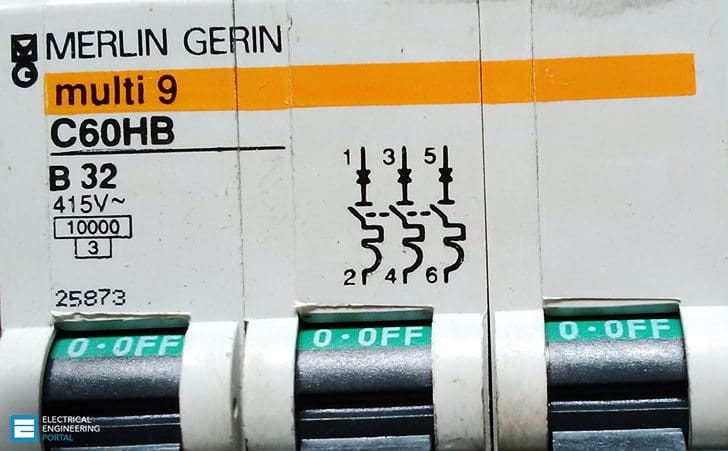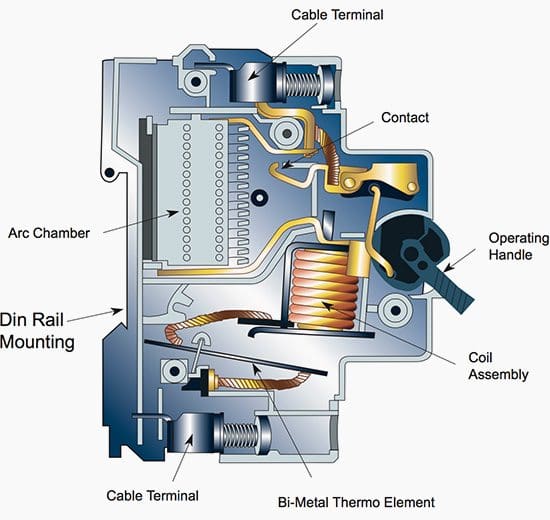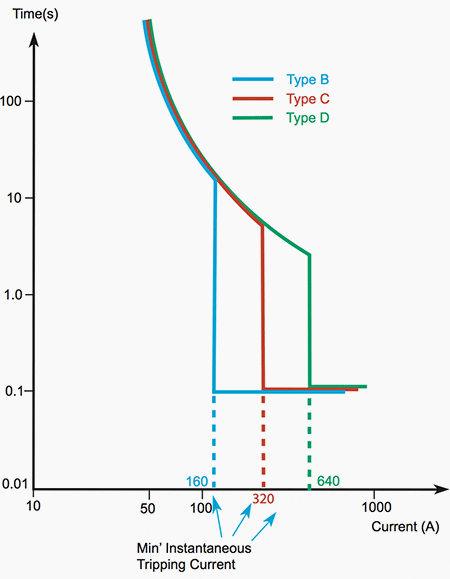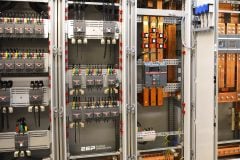MCB Operation and characteristics
Miniature circuit breaker – MCB is a thermo-magnetic device, meaning that it has two methods of circuit interruption. A thermal mechanism, usually a bi-metallic strip, provides protection against moderate overcurrent.

The heating action of the current causes the bi-metallic strip to curve and break circuit contact. This method is complemented by a solenoid designed to respond to larger currents.
A diagram of an MCB is shown in Figure 1 below.


It should be apparent that the thermal trip has a slow response time and the solenoid trip has a rapid response time. When combined, these devices provide quite a sophisticated protection characteristic profile.
Table 1 //
BS EN 60898 device thermal characteristics
| Current | Desired Result |
| 1.13 In | Must not trip within 1 h |
| 1.45 In ≤ 63A | Must trip within 1 h |
| 1.45 x In, > 63A | Must trip within 2 h |
| 2.55 In ≤ 32A | Must trip between 1 and 60 s |
| 2.55 In, > 32A | Must trip between 1 and 120 s |
The two MCB’s characteristics are described:
1. Thermal characteristic
The thermal, bi-metallic characteristic is summarized in Table 1. A further co-ordination of the requirement is that of Regulation 433.1.1 (iii) which is:
I2 ≤ 1.45 × Iz where I2 is the current that causes operation of the device.
By studying Table 1 above, it can be seen that this requirement is built into the product standard for BS EN 60898 devices and is effectively the calibration of the bi-metallic strip.
2. Magnetic characteristic
The maximum rated current available for MCBs is 125A, and these BS EN 60898 devices are available with different magnetic sensitivities, denoted with a prefix B, C or D accordingly.
The different magnetic characteristics of BS EN 60898 circuit breakers are provided in Appendix 3 of BS 7671: 2008, but to illustrate the differences in the magnetic characteristics, Figure 2 shows a comparison of B, C and D types for devices of the same basic rating. A 32A circuit breaker with type C sensitivity is denoted C32, and it is a requirement of the equipment standard to apply this marking to the device.
This minimum time convention is due to the mechanics of the circuit breaker, which will always require a certain minimum time, regardless of current for the trip mechanism to open.


Figure 2 shows that in order to achieve instantaneous tripping or tripping at 0.1 s, a 32A type B breaker requires 160A, a type C breaker 320A and a type D breaker 640A.
Table 2 //
Circuit breaker (BS EN 60898) selection for inrush current applications
| Type | Manufactured magnetic trip setting (× In) | Typical applications |
| B | 3 to 5 | General domestic and resistive loads |
| C | 5 to 10 | Small motors (a few kW), small transformers fluorescent lighting and most inductive loads |
| D | 10 to 20 | DOL motors, large star delta motors, low- pressure sodium discharge lighting, larger transformers, welding machine supplies |
Below these threshold currents the thermal mechanism is dominant, and has the same characteristic for all three devices. The magnetic characteristics determine the sensitivity type. Equipment connected or likely to be connected to the circuit must be assessed in terms of likely peak or inrush current.
Inrush current is the current that a load draws when the supply is switched on.
Values can range from being insignificant (a few times the normal current), 5 to 10 times normal current for iron core transformers (e.g. conventional ballast fluorescent luminaires) and up to 20 times normal current for much modern electronic equipment, including the power supplies found in user equipment.
While short-lived (often the peak current is a few milliseconds), this can cause circuit breakers to trip, but assessing the likelihood of a circuit breaker tripping is complicated. Table 2 above recommends circuit breaker types for typical inrush current applications.
If you have loads with significant cyclic peaks you need to confirm that the circuit breaker will not trip. This can be confirmed by studying the circuit breaker characteristic curve, but confirmation with the manufacturer may be necessary.
Circuit Breakers – How they Work, What’s Inside
How does a Miniture Circuit Breaker (MCB) work
Reference // Guide to the Wiring Regulations – Darrell Locke IEng MIEE ACIBSE











Sir,
It is learned that, the let through energy of a 32A MCB is 1110000A2Sec.
Let me kindly be informed, how this value is arrived.
Pls review table 1 against IEC 60898.
Can I use above image in my YouTube channel for explanation..
Thank you
Clear and concise explanation , thank you so much :) .
Nice one sir. Thanks for so much info through this portal.
You’re welcome Arslan.
Excellent article. Everything you need to know about ‘breakers’ summarised
Sir edvard thank you…sir if i may ask what are the common tests done to a building during the turnover or testing and commissioning? thanks and God Bless.
Thank you sir edvard for this…God Bless…would just like to ask sir what are the tests conducted on a building during turnover or testing and commissioning exercises? Thanks again sir.
excellent this is very use full to Me Thank a lot ….
Hello everybody I have 220 VAC /20A circuit breaker can I use it for 12 VDC of 20A load ? Please help me.
Good news
Hi, Edvard!
I hope You are Ok!
I’m got from You another important informations in my job.
Thank You!
Excellent, I’m glad for you!
Thank you for your insight and information. Great Information for my customers. Can we share this?
Sure, that’s the whole point :)
Maybe what is missing is the use of MCB in DC. Tripping values are different. Unless I have overlooked it?
Regards Mil Zec
Good notice, but I haven’t consider DC MCB at all, it’s about the most common AC MCBs.
thank you edvard hope too much progress for you and your partenrs
You’re welcome Mahmoud!
very interesting
Hi Edvard,
Then there is overload capability for MCBs ?
for how many times In and for how long?
Yes, MCB has circuit protection against both short-circuit currents and overload currents. On this example from main picture, MCB with B curve will trip on 3,5xIn and without any delay, immediately.
Thanks Edvard, I used to teach faculty of engineering students a distribution course, can I use the material supplied in this technical note?
Of course Tarek!
Another very informative and concise reference.
Thank you Stephen.
In the MCB image above c60HB means..
This is the complete meaning of MCB nameplate from above MCB picture:
C60 – Circuit breaker model number (Schneider Electric // Merlin Gerin)
B – Magnetic characteristic, type B
H – Limitation capability of MCB, in this case of 3-pole up to 63A (like on pic) is 15kA
B32 – Tripping curve, set to 32A
415V – Operating voltage
10000 – Rated breaking capacity (in Amps)
3 – I2t classification